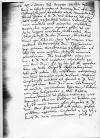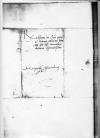Binas habui a Reverendissima Dominatione Vestra litteras utrisque satis mihi respondisse videor.
Ceterum de arca nondum erat quicquam constitutum neque sine magno negotio effeci, ut eis seria magis mandata scriberentur. Non solus fortasse Jan Benedyktowicz Solfa (Ioannes Benedicti de Trebul, Ioannes Benedicti Solpha) (*1483 – †1564), physician, lawyer, poet and historian; in 1541 ennobled by Emperor Charles V of Habsburg; from 1521 Canon of the Collegiate Chapter in Glogau (Głogów); from 1522 court physician of King Sigismund I Jagiellon; from 1526 Canon of Ermland (Warmia); from ca. 1528 Canon of Vilnius; from 1529 Canon of St. John’s Collegiate Church in Warsaw; from 1531 Custos of Łowicz; from 1538 Canon of Wrocław (Breslau); from 1539 Canon of Sandomierz; from 1547 Canon of Cracow and Provost of Ermland (KOŻUSZEK, passim)⌊doctor IoannesJan Benedyktowicz Solfa (Ioannes Benedicti de Trebul, Ioannes Benedicti Solpha) (*1483 – †1564), physician, lawyer, poet and historian; in 1541 ennobled by Emperor Charles V of Habsburg; from 1521 Canon of the Collegiate Chapter in Glogau (Głogów); from 1522 court physician of King Sigismund I Jagiellon; from 1526 Canon of Ermland (Warmia); from ca. 1528 Canon of Vilnius; from 1529 Canon of St. John’s Collegiate Church in Warsaw; from 1531 Custos of Łowicz; from 1538 Canon of Wrocław (Breslau); from 1539 Canon of Sandomierz; from 1547 Canon of Cracow and Provost of Ermland (KOŻUSZEK, passim)⌋ sollicitabat. Nunc ego futurum spero, ut omnino eam tradant Gedanenses domino Stanisław Kostka (*1487 – †1555), as a leader of the so-called nobles' party active in Royal Prussia since 1536, Kostka stood in opposition to most of the members of the Council of Royal Prussia, who wanted to maintain the autonomy of the province and a "balance of power" in terms of governance. The tension between the Prussian Subtreasurer and the Council had been increasing since the Diet in Graudenz (Grudziądz) in 1533. Kostka, connected with the royal court since his youth, was sent to Graudenz as the King's deputy and, contrary to custom, decided to take part in the proceedings. In response to such a step, the Council members stopped the meeting. Kostka accused them of hostility towards the Poles and intervened on this matter at the court. In the absence of the then Bishop of Ermland (Mauritius Ferber) it was Dantiscus who chaired the Graudenz Diet. The incident badly harmed his future relationships with Kostka; 1531-1555 Treasurer of the Prussian lands and Treasurer of Marienburg (Malbork); 1544-1545 Castellan of Elbing (Elbląg), 1545-1546 Castellan of Kulm (Chełmno); 1546-1549 Vice-Voivode of Kulm; 1546-1551 Voivode of Pomerania; 1551-1555 Voivode of Kulm (PSB 14, p. 356; Urzędnicy 5/2, p. 216; MAŁŁEK 1976, p. 119-123)⌊thesaurarioStanisław Kostka (*1487 – †1555), as a leader of the so-called nobles' party active in Royal Prussia since 1536, Kostka stood in opposition to most of the members of the Council of Royal Prussia, who wanted to maintain the autonomy of the province and a "balance of power" in terms of governance. The tension between the Prussian Subtreasurer and the Council had been increasing since the Diet in Graudenz (Grudziądz) in 1533. Kostka, connected with the royal court since his youth, was sent to Graudenz as the King's deputy and, contrary to custom, decided to take part in the proceedings. In response to such a step, the Council members stopped the meeting. Kostka accused them of hostility towards the Poles and intervened on this matter at the court. In the absence of the then Bishop of Ermland (Mauritius Ferber) it was Dantiscus who chaired the Graudenz Diet. The incident badly harmed his future relationships with Kostka; 1531-1555 Treasurer of the Prussian lands and Treasurer of Marienburg (Malbork); 1544-1545 Castellan of Elbing (Elbląg), 1545-1546 Castellan of Kulm (Chełmno); 1546-1549 Vice-Voivode of Kulm; 1546-1551 Voivode of Pomerania; 1551-1555 Voivode of Kulm (PSB 14, p. 356; Urzędnicy 5/2, p. 216; MAŁŁEK 1976, p. 119-123)⌋. Per quorum secretarium responsum est illis de arca missum, fortassis minime placiturum. De parochiali, quam per Mikołaj Loka (Mikołaj Lok) (†1569), collaborator of Stanisław Hozjusz as a royal secretary; in 1545-1547 he stayed in Rome; 1540 Ermland canon; 1547 - Poznań; 1560 abbot of the Cistercian monastery in Oliwa; 1550 envoy to the Prussian diet on behalf of King Sigismund II August (SZORC 1990, p. 331; KOPICZKO 2, p. 201)⌊LocaMikołaj Loka (Mikołaj Lok) (†1569), collaborator of Stanisław Hozjusz as a royal secretary; in 1545-1547 he stayed in Rome; 1540 Ermland canon; 1547 - Poznań; 1560 abbot of the Cistercian monastery in Oliwa; 1550 envoy to the Prussian diet on behalf of King Sigismund II August (SZORC 1990, p. 331; KOPICZKO 2, p. 201)⌋ Reverendissima Dominatio Vestra impetrari cupiebat, egi cum Samuel Maciejowski (*1499 – †1550), humanist and diplomat, one of the most trusted advisors to King Sigismund I and then to his son Sigismund II Augustus; from 1521 Canon of the Collegiate Chapter in Sandomierz, and from 1530 in Kielce; from 1531 Canon of Gniezno; from 1532 or 1533 to 1537 royal secretary (previously scribe at the royal chancellery); 1537-1539 Grand Secretary; 1539-1547 Crown Vice-Chancellor; 1539-1541 Bishop of Chełm; 1541-1545 Bishop of Płock; 1545-1550 Bishop of Cracow; 1547-1550 Crown Grand Chancellor; in 1532 royal envoy to Rome; in 1534 and 1538 royal envoy to the local diets (WYCZAŃSKI 1990, p. 257-258; Urzędnicy 10, p. 184; PSB 19 Machowski - Maria Kazimiera, p. 64-69)⌊reverendissimo dominoSamuel Maciejowski (*1499 – †1550), humanist and diplomat, one of the most trusted advisors to King Sigismund I and then to his son Sigismund II Augustus; from 1521 Canon of the Collegiate Chapter in Sandomierz, and from 1530 in Kielce; from 1531 Canon of Gniezno; from 1532 or 1533 to 1537 royal secretary (previously scribe at the royal chancellery); 1537-1539 Grand Secretary; 1539-1547 Crown Vice-Chancellor; 1539-1541 Bishop of Chełm; 1541-1545 Bishop of Płock; 1545-1550 Bishop of Cracow; 1547-1550 Crown Grand Chancellor; in 1532 royal envoy to Rome; in 1534 and 1538 royal envoy to the local diets (WYCZAŃSKI 1990, p. 257-258; Urzędnicy 10, p. 184; PSB 19 Machowski - Maria Kazimiera, p. 64-69)⌋, sed visum est illi exspectare, dum ex Rome (Roma), city in central Italy, on the Tiber river, seat of the Holy See⌊urbeRome (Roma), city in central Italy, on the Tiber river, seat of the Holy See⌋ aliquid afferretur prius, ubi quid actum sit, nihildum accepimus.
Hic Sigismund I Jagiellon (Zygmunt I) (*1467 – †1548), King of Poland and Grand Duke of Lithuania (1506-1548); Duke of Głogów (Glogau) (1499-1506), Duke of Opava (1501-1506), Governor of Silesia (1504-1506); son of King Kazimierz IV Jagiellon and Elisabeth of Austria
Bona Sforza (*1494 – †1557), Queen of Poland and Grand Duchess of Lithuania (1518-1557); the second wife of Sigismund I Jagiellon; Duchess of Bari and Rossano; daughter of Gian Galeazzo Sforza of Milan and Isabella of Aragon⌊serenissimi principesSigismund I Jagiellon (Zygmunt I) (*1467 – †1548), King of Poland and Grand Duke of Lithuania (1506-1548); Duke of Głogów (Glogau) (1499-1506), Duke of Opava (1501-1506), Governor of Silesia (1504-1506); son of King Kazimierz IV Jagiellon and Elisabeth of Austria
Bona Sforza (*1494 – †1557), Queen of Poland and Grand Duchess of Lithuania (1518-1557); the second wife of Sigismund I Jagiellon; Duchess of Bari and Rossano; daughter of Gian Galeazzo Sforza of Milan and Isabella of Aragon⌋ recte valent. Jan Latalski (*1463 – †1540), brother of Janusz Latalski, Voivode of Poznań; 1495-1525 Canon of Poznań, 1498-1505 Chancellor to Elizabeth of Austria, Queen of Poland; 1500-1525 Provost of the Gniezno Chapter, 1503-1525 Provost of the Cracow Chapter, 1504-1524 royal secretary, 1523-1525 Provost at the Poznań Chapter, 1525-1536 Bishop of Poznań, 1536-1537 Bishop of Cracow, 1537-1540 Archbishop of Gniezno (PSB 16, p. 562)⌊Archiepiscopus GnesnensisJan Latalski (*1463 – †1540), brother of Janusz Latalski, Voivode of Poznań; 1495-1525 Canon of Poznań, 1498-1505 Chancellor to Elizabeth of Austria, Queen of Poland; 1500-1525 Provost of the Gniezno Chapter, 1503-1525 Provost of the Cracow Chapter, 1504-1524 royal secretary, 1523-1525 Provost at the Poznań Chapter, 1525-1536 Bishop of Poznań, 1536-1537 Bishop of Cracow, 1537-1540 Archbishop of Gniezno (PSB 16, p. 562)⌋ mortuus est. Fecerit Reverendissima Dominatio Vestra rem gratam Samuel Maciejowski (*1499 – †1550), humanist and diplomat, one of the most trusted advisors to King Sigismund I and then to his son Sigismund II Augustus; from 1521 Canon of the Collegiate Chapter in Sandomierz, and from 1530 in Kielce; from 1531 Canon of Gniezno; from 1532 or 1533 to 1537 royal secretary (previously scribe at the royal chancellery); 1537-1539 Grand Secretary; 1539-1547 Crown Vice-Chancellor; 1539-1541 Bishop of Chełm; 1541-1545 Bishop of Płock; 1545-1550 Bishop of Cracow; 1547-1550 Crown Grand Chancellor; in 1532 royal envoy to Rome; in 1534 and 1538 royal envoy to the local diets (WYCZAŃSKI 1990, p. 257-258; Urzędnicy 10, p. 184; PSB 19 Machowski - Maria Kazimiera, p. 64-69)⌊reverendissimo domino meo ChelmensiSamuel Maciejowski (*1499 – †1550), humanist and diplomat, one of the most trusted advisors to King Sigismund I and then to his son Sigismund II Augustus; from 1521 Canon of the Collegiate Chapter in Sandomierz, and from 1530 in Kielce; from 1531 Canon of Gniezno; from 1532 or 1533 to 1537 royal secretary (previously scribe at the royal chancellery); 1537-1539 Grand Secretary; 1539-1547 Crown Vice-Chancellor; 1539-1541 Bishop of Chełm; 1541-1545 Bishop of Płock; 1545-1550 Bishop of Cracow; 1547-1550 Crown Grand Chancellor; in 1532 royal envoy to Rome; in 1534 and 1538 royal envoy to the local diets (WYCZAŃSKI 1990, p. 257-258; Urzędnicy 10, p. 184; PSB 19 Machowski - Maria Kazimiera, p. 64-69)⌋ et mutua coniunctione dignam, si litteris eum suis diligenter
s(erenissimae) or s(acrae)⌈s(erenissimae)s(erenissimae) or s(acrae)⌉
Sigismund I Jagiellon (Zygmunt I) (*1467 – †1548), King of Poland and Grand Duke of Lithuania (1506-1548); Duke of Głogów (Glogau) (1499-1506), Duke of Opava (1501-1506), Governor of Silesia (1504-1506); son of King Kazimierz IV Jagiellon and Elisabeth of Austria⌊maiestati regiaeSigismund I Jagiellon (Zygmunt I) (*1467 – †1548), King of Poland and Grand Duke of Lithuania (1506-1548); Duke of Głogów (Glogau) (1499-1506), Duke of Opava (1501-1506), Governor of Silesia (1504-1506); son of King Kazimierz IV Jagiellon and Elisabeth of Austria⌋ commendaverit, ut habere rationem eius dignetur. Quam habitam iri, dubium non est, sed amici tamen officio fungetur Reverendissima Dominatio Vestra. Qui has perfert, intricatum habet quoddam negotium. Contendit a me, ut se Reverendissimae Dominationi Vestrae commendarem, quod ei  LSB, Br 26, No. 2_2 negare non potui. Quantum fides et religio Reverendissima Dominatio Vestra patietur, quaeso, ut ei hidden by binding⌈[i]i hidden by binding⌉ deesse nolit.
Deum precor, ut Reverendissimam Dominationem Vestram diu servet incolumem. Cuius me gratiae hidden by binding⌈[e]e hidden by binding⌉ commendo.
LSB, Br 26, No. 2_2 negare non potui. Quantum fides et religio Reverendissima Dominatio Vestra patietur, quaeso, ut ei hidden by binding⌈[i]i hidden by binding⌉ deesse nolit.
Deum precor, ut Reverendissimam Dominationem Vestram diu servet incolumem. Cuius me gratiae hidden by binding⌈[e]e hidden by binding⌉ commendo.
 LSB, Br 26, No. 2_2 negare non potui. Quantum fides et religio Reverendissima Dominatio Vestra patietur, quaeso, ut ei hidden by binding⌈[i]i hidden by binding⌉ deesse nolit.
Deum precor, ut Reverendissimam Dominationem Vestram diu servet incolumem. Cuius me gratiae hidden by binding⌈[e]e hidden by binding⌉ commendo.
LSB, Br 26, No. 2_2 negare non potui. Quantum fides et religio Reverendissima Dominatio Vestra patietur, quaeso, ut ei hidden by binding⌈[i]i hidden by binding⌉ deesse nolit.
Deum precor, ut Reverendissimam Dominationem Vestram diu servet incolumem. Cuius me gratiae hidden by binding⌈[e]e hidden by binding⌉ commendo.


